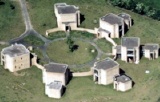EPSRC Symposium Capstone Conference
Mini Symposium on Computational Methods for Interfaces and Surfaces
Organiser: Charlie Elliott
Friday 3 July 2009
Speakers
- Lubomir Banas (Heriot-Watt) Finite element approximation of a phase field model for multi-fluid incompressible magnetohydrodynamics
We propose an implicit finite element method for a phase field approximation of time dependent multi-fluid incompressible magnetohydrodynamics. The proposed discretization satisfies a discrete energy law. We discuss computational aspects of the method and present some numerical experiments.
- Martin Rumpf (Bonn) Geodesics in Shape Space via Variational Time Discretization
- Bjorn Stinner (Warwick) On a Surface Finite Element Method for Biomembranes with Lipid Decomposition
Bilayers consisting of lipids molecules are the basic component of cell membranes. Vesicles formed from such biomembranes show a variety of interesting shapes that can be explained by its elastic bending energy. Due to inhomogeneities the lipids may separate and form different phases on the membrane which results in an energy contribution from the phase interfaces. We have been numerically studying equilibrium shapes, i.e., local energy minima by relaxing suitable initial shapes. A suitable (kind of) gradient flow dynamics has been defined for this purpose where the inter-membrane domains are described using the phase field methodology. The governing equations consist of pde on the membrane surface describing the phase separation coupled to a geometric evolution law for the membrane. The discretisation is based on representing the membrane by a triangulated surface on which quadratic parametric FEs are defined. The convergence as grid parameter and diffuse interface thickness tend to zero has been numerically investigated. Further issues are the sharp interface limit of the phase-field approach and adaptive mesh refinement.
- V Styles (Sussex) Primal-dual active set methods for Allen-Cahn variational inequalities
See also:
Mathematics Research Centre
Mathematical Interdisciplinary Research at Warwick (MIR@W)
Past Events
Past Symposia
Where possible, visitors should obtain an EDUROAM account from their own university to enable internet access whilst at Warwick.
You can register for any of the symposia or workshops online. To see which registrations are currently open and to submit a registration, please click hereLink opens in a new window.
Mathematics Research Centre
Zeeman Building
University of Warwick
Coventry CV4 7AL - UK
E-mail:
MRC@warwick.ac.uk

